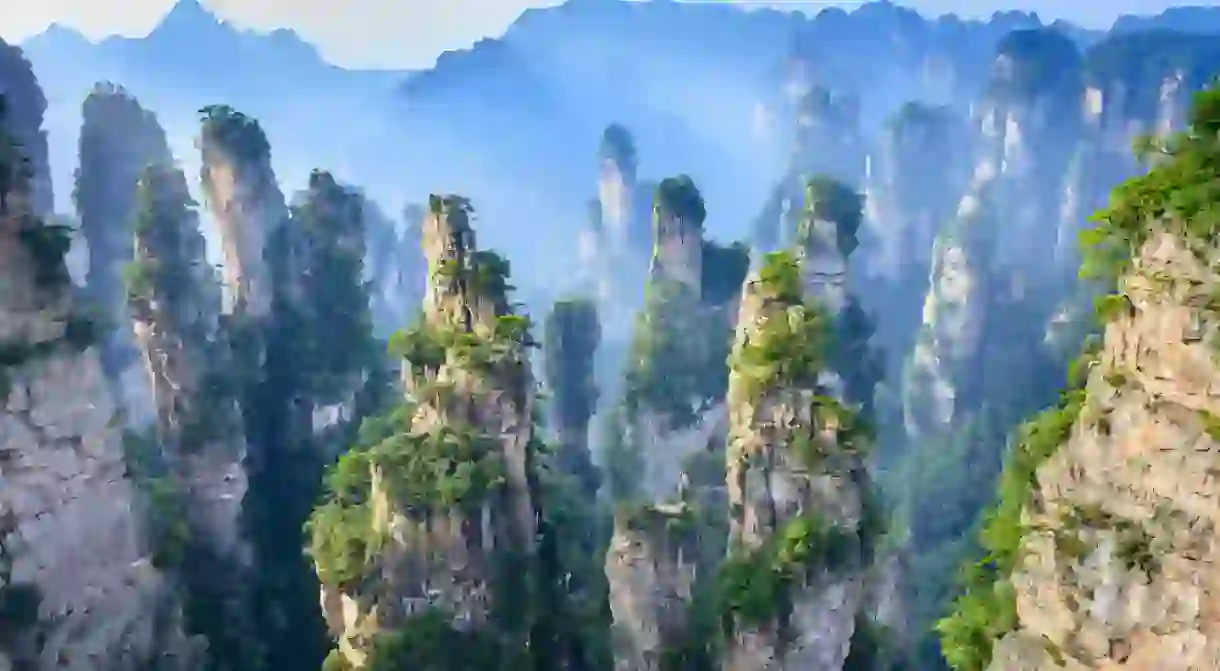China's Most Stunning Wonders Have to Be Seen to Be Believed

China remains a mystery for most travellers, but with the second highest concentration of UNESCO World Heritage sites after Italy there’s so much to discover beyond the tourist tropes of Shanghai and Beijing. From colossal mountain statues and gravity-defying topography to pristine national parks and awe-inspiring temples these are just some of the wonders you can’t afford to miss.
Mount Qingcheng
Mount Qingcheng forms part of an ancient system that uses natural topography and hydrological features for irrigation, draining sediment and helping with flood and flow control without the need for dams. The mountain is also famous as the place where philosopher Zhang Ling founded Taoism in 142CE.

South China Karsts
The stone forests of Shilin are considered the world’s best examples of tower, pinnacle and cone karsts – landscapes formed from the dissolution of soluble rocks such as limestone, dolomite, and gypsum over millions of years. Wulong Karst is widely known for its giant sinkholes, natural bridges and caves.

Huashan Rock Art
These ancient pictographs were created by the Luoyue people and illustrate the lives and rituals of our ancestors between the 5th century and 2nd century CE. They depict ceremonies and festivals and were once prevalent across Southern China. These are the only remains of this culture today.

Leshan Giant Buddha
At 71 metres high, the Giant Buddha of Leshan is the largest Buddha in the world. It was carved from a hillside on Mount Emei in the 8th century, the place where Buddhism first became established in China. The mountain is also home to incredible, diverse subtropical and subalpine forests.

Jiuzhaigou Valley
The valley is well worth a visit not just for its amazing karsts and spectacular waterfalls, but also for its wildlife which includes 149 bird species, giant panda and the Sichuan takin – a subspecies of goats and antelope.

Wulingyuan
This area of astounding natural beauty stretches 26,400 hectares throughout China’s Hunan Province and is dominated by more than 3,000 gravity-defying quartz sandstone pillars. Between these impressive structures are countless ravines with streams, pools, waterfalls and caves waiting to be explored.

Cemetery of Confucius
Built in 478 BC the Temple of Confucius, commemorating the great philosopher and teacher was destroyed and rebuilt over the centuries. Its 104 buildings, dating from the Jin to Qing dynasties, are home to more than 1,000 stelae (sculpted stone shafts) and precious objects such as Han stone reliefs and stone dragon carvings. It is the model for all Confucius temples across East and Southeast Asia.

Macao Historic Centre
Before it was the home of gambling in Asia, Macau was once an important trading post and Portuguese settlement in the mid-16th century. The Historic Centre of Macao is a unique meeting of East and West, such as the incorporation of Chinese characters in the church façade of St. Paul’s Ruins. Public squares blending into the densely packed narrow, meandering streets also lend a European air.

Old Silk Road
Not to be confused with the dark web marketplace, the Silk Road was once the world’s most important long-distance trade and communication network in the world. The routes, thousands of kilometres long, were used to transfer raw materials, foodstuffs, and luxury goods. The series of Buddhist pagodas and large, elaborate cave temples extending from Kucha in the West to Luoyong in the east, record the eastward transmission of Buddhism from India via Karakorum.

Longmen Grottoes
The Longmen Grottoes are made up of over 2,300 caves and niches carved into the steep limestone cliffs over a 150 year period, containing almost 110,000 Buddhist stone statues, more than 60 stupas – structures for meditation – and 2,800 inscriptions carved on steles. Yaofangdong Cave contains 140 inscriptions recording treatments for various diseases and illnesses.

Temple of Heaven
Founded in the first half of the 15th century, The Temple of Heaven symbolizes the relationship between earth and heaven – the human world and God’s world – which stands at the heart of Chinese cosmogony. The original Altar of Heaven and Earth was completed together with the Forbidden City in 1420.














